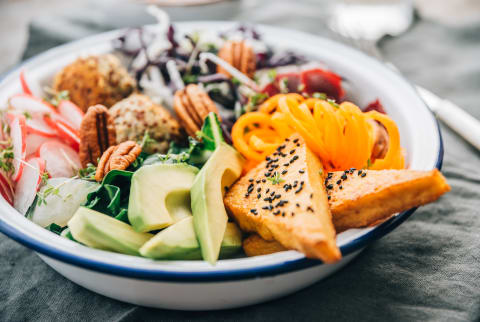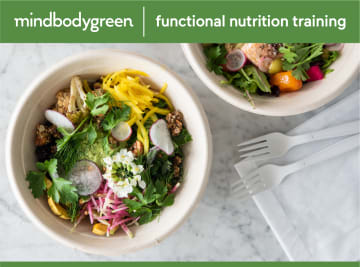We investigated the benefits of fasting and the keto diet, and here’s what we learned about the benefits of pairing them and how to do so safely and effectively. Very briefly, IF is unlike other “diets” in that it’s just a pattern of eating based on time rather than food choices. The most common form of IF is time-restricted eating (TRE), which will be the focus of this article. TRE limits daily food intake to a fixed window of each day, typically ~8 hours. The eating window usually aligns with daylight. This leaves a ~16-hour fasting window that happens when the sun is set. This pattern of eating is thought to align with our natural internal clocks and support our circadian systems3 to maximize the timing of biological processes. For example, glucose tolerance (blood sugar response to carbohydrates) is better in the morning4 than it is at night. As nutrition scientist Courtney Peterson, Ph.D., says on the mindbodygreen podcast, “We’ve actually known for about the past 50 years that your blood sugar control in most people is best in the morning, and it gets worse as the day progresses.” While the evidence linking IF with real hard clinical outcomes is limited, it is definitely a tool that shouldn’t be ignored. Fasting is also not some new concept or “fad.” Fasting has a history dating back millenniums as a therapy used to cure disease and as a religious practice that benefits the mind and body. Our biology is well equipped to go long periods without food. If it wasn’t, we wouldn’t be here today! This high-fat, very low-carbohydrate diet mimics human fasting metabolism and was used medically in the early 1900s to manage epileptic seizures5 as well as Type 1 diabetes6 before the advent of insulin. Keto is a way of eating that restricts carbohydrates to the point that our body needs to vet out an alternative fuel source to feed our glucose-hungry brain. (Unlike most of our tissues, the brain cannot burn fats for fuel.) That’s where ketones come in. When we lower carbohydrate intake, and by virtue, blood sugar and insulin levels, to the point that puts the brain at risk of an energy deficit, the liver starts converting fats (either from our diet or body fat stores if in a caloric deficit) into ketones. This is what defines a keto diet: an elevation of ketones. It turns out that the brain loves ketones so much that it uses them even in the face of impaired energy metabolism. Ketones do a lot of other extraordinary things in the body that scientists are still unpacking. Today, the ketogenic diet is being researched in various clinical settings for its effect on cancer7, neurodegenerative diseases8, and most notably, Type 2 diabetes9. It also shows promise for promoting brain health and treating mental health conditions10. “A ketogenic diet is a really important tool for people who are trying to improve their brain’s access to energy and the overall health of their brain’s metabolism,” nutritional psychiatrist Georgia Ede, M.D., says on the mindbodygreen podcast. Remember, the ketogenic diet was introduced as a dietary means of mimicking fasting. Because of this, they pair up nicely and often, are practiced in concert. Keto takes care of food choice (what to eat), while IF takes care of food timing (when to eat). Here are some reasons to combine the two: If you go cold turkey into a fast from a high-carbohydrate diet, you will most likely experience some symptoms of low energy, low blood sugar, and hunger as your body transitions into ketosis. It would be like stepping out of a sauna into the winter air. Beginning a fast off of a keto diet, however, is more seamless. It’s less of a shock to the system since your metabolism is already happily running on fats and ketones. It’s more like coming out of a sauna into warm sunlight. So, if you are new to IF, a keto diet can help smooth the transition. A ketogenic diet can also, in many cases, make intermittent fasting easier. This is because fasting is the most cut-and-dried way to stimulate your body’s own ketone production11 since it removes all glucose sources by removing all food. If you are following a ketogenic diet, intermittent fasting is a great tool for emptying your body’s glucose stores, the way a keto diet does as well. So, if you are eating a ketogenic diet and find you only really need two meals a day (maybe you aren’t hungry throughout the morning, or you no longer desire that snack after dinner), well, now you’re well on your way to time-restricted eating. In addition, if you find a keto diet helps you intermittently fast with ease, this frees up hours of your day that might otherwise be spent thinking about, preparing, and eating food. This is an overlooked benefit of intermittent fasting that extends beyond metabolism and body weight and really could in some cases improve quality of life. Whether or not the pair supports weight loss will come down to the individual since adherence to any diet is the best predictor of weight loss. In other words, if you can stick to a keto diet while intermittent fasting, then you will likely find success! However, if your intermittent fasting schedule leads you to binge on a tub of keto ice cream at the end of the day, then this strategy is not for you. As of now, no research trials have studied using a ketogenic diet alongside time-restricted feeding for weight loss. However, given the promise of both interventions, it is likely that those studies will eventually be done, It’s worth noting that there is one case study12 of a woman with Type 2 diabetes who was able to dramatically improve glycemic control by sticking to a ketogenic diet and utilizing prolonged fasts (24- to 42-hour fasts 3 days/week). She maintained these results using daily 16-hour fasts. Someone that doesn’t want to lose weight? Combining keto and IF might still lead to a caloric deficit in your case, and spur weight loss that you weren’t necessarily going for. Real food should always be what makes up the vast majority of the diet. Opting for whole foods will also reduce the time you need to spend figuring out whether some ingredient listed on your packaged food that you can’t even pronounce is “keto.” When paired with resistance training, adequate protein intake will be important for maintaining or building muscle15 in the face of long durations (e.g., 16 hours) without food. Protein will also help with appetite management if you find yourself unable to stick to your IF schedule because you’re absolutely ravenous. Protein helps us stay full for longer, so use this to your advantage! Again, stick to whole food sources like eggs, meats, and seafood, or opt for high-quality plant protein if you are vegan or vegetarian. His research protocol suggests avoiding eating at least two to three hours before your regular bedtime, eating after the sun has risen, and eating within a 12-hour window. Within this framework, you can adjust your exact eating window based on your schedule, lifestyle, and preference. Maybe you skip breakfast and eat from noon to 8 p.m. or skip dinner and eat from 8 a.m. to 4 p.m., for example. There is research to suggest if you are trying to optimize for metabolic health and glycemic control, then eating earlier in the day (i.e., early TRE) is best. You just want to make sure the window isn’t so short that you can’t comfortably eat the calories and nutrition you need to support your activity, ideal body weight, and nutritional needs. It also should not be too long that it doesn’t do much to help you achieve your goals. If your goals are to maximize muscle gains, for example, you’ll want to position your eating window to begin when you complete your workout. You could also train within your eating window. When compared to eating over the course of the day, resistance training paired with TRE18 (when training takes place in the eating window) leads to similar gains in muscle. Though, there is also a study19 that found training in the fasted state may increase our muscle’s response to protein intake post-exercise. So, it is likely that you can train the way you prefer (fed versus fasted) without worry. To optimize recovery, choose an eating window in close proximity to your gym session and ensure adequate protein intake post-workout. Option 2: Chia pudding with full-fat coconut cream, protein powder, and chopped nuts. Option 2: Smoothie with high-fat dairy or nut milk as base, protein powder, greens, nut butter, and a handful of berries (optional). If you’ve never subbed frozen fruit for steamed then frozen cauliflower, give it a go! It thickens up your smoothies as a frozen banana would. Option 2: Taco bowls with mince (chicken, beef, turkey, etc.) seasoned with taco spices and cooked with lots of onions and garlic, served over cauliflower rice, with avocado, salsa, shredded cheese, chopped jalapeños, and cilantro. Top with tahini mixed with lime juice. Option 2: A square of 90-100% dark chocolate. Keto and TRE, both separate and paired, are not recommended for pregnant and breastfeeding women, and you should seek professional advice from your doctor if you are interested in either from a health perspective depending on your current health status. Those who may be vulnerable to unwanted weight loss or calorie restriction such as young, lean, and/or very active individuals as well as menstruating women are at higher risk for side effects, if pairing the two makes it difficult to consume enough calories and nutrition.





